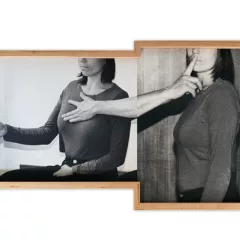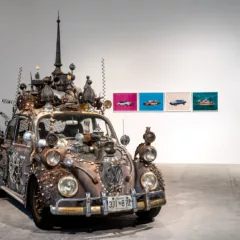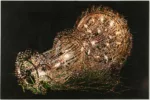Sheila Hicks; 50 Years at the Institute of Contemporary Art (ICA), University of Pennsylvania through August 7, 2011 is likely to knock you off your feet with its power and get you high on color; it will certainly expand your idea of what can be made out of yarn and second-hand clothes. The survey of more than ninety works ranges from the monumental May I have this Dance? (2002-03), whose cable-like forms burst out of the far corner of the ICA’s double-story space and fall in loops across twenty-five feet of floor, to the series of flat works, no more than 10″ in either dimension, that line two walls.
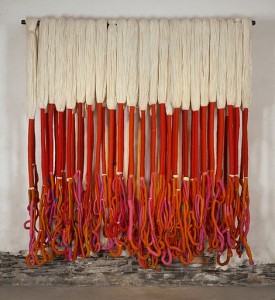
The spaces of the ICA have never looked better; the unadorned, brutalism of its concrete interior is warmed by Hicks’ intense colors and soft, tactile forms. In the lobby, two works suspended above the door have been fashioned from white, cotton hospital garments for newborns; they’ve been stitched together to form pierced, white banners that move gently with the air currents. Past the entrance to the first floor galleries are floor pieces, wall hangings and installations that fairly scream Touch me! Touch me! and the only disappointment of this exhibition is that one can’t touch. I was immediately attracted to the glowing, golden pile of bound yarn that constitutes Banisteriopsis (1965-66). It’s one of three free-standing sculptures which sit together, each made of piles of linen thread bound into skeins which have been piled one upon another, without armatures; in fact, each work can be be laid out differently on different occasions. The title of the yellow piece refers to a hallucinatory plant extract, so the headiness I felt made sense. I wanted to crawl into the soft, fuzzy and seductive, golden pile.
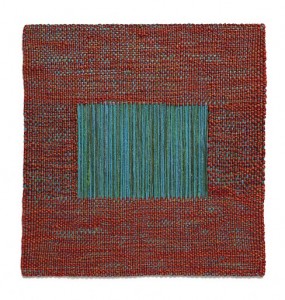
Hicks was trained as a painter at Yale where she took a course with George Kubler, historian of pre-Columbian art and influential art theorist. She studied weaving independently with Anni Albers, wrote her thesis on Andean textiles, and would ultimately travel around the world to study textile traditions. Her study of worldwide weaving techniques, many of them practiced by tribal peoples, could be interpreted as a form of primitivism; in fact it was the opposite. Rather than looking for a simpler art, untouched by modernity, Hicks was recovering the remains of sophisticated textile making whose artistry was being lost in the rush towards industrialization.
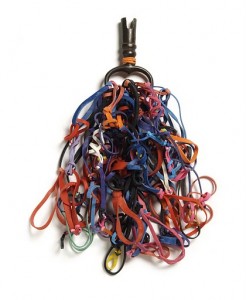
Hicks has been well-known internationally among architects and designers and has received international commissions for public buildings (among them the Ford Foundation Building, New York, the Banco de Mexico Headquarters, Mexico City, and the Fuji City Cultural Center, Japan) as well as teaching appointments worldwide. Yet, the fact that she’s lived in Paris since 1964, and the divisions of art versus craft have allowed her work to be under-represented in American art museums. Although she has had solo exhibitions in museums devoted to craft and decorative arts, university galleries and art centers, her last solo exhibition in a major American art museum was in 1963. She has had numerous museum exhibitions in Europe, Japan and Israel.
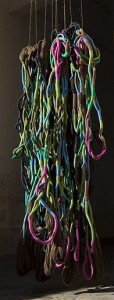
Considering Hicks’ study of weaving history, only a small amount of work in the exhibition involves weaving. These are mostly the series of more than sixty small, framed pieces, which Hicks calls miniatures, that she creates on a small, portable wooden frame; in their experimental variety and materials, which range from silk to paper, human hair, bamboo and steel wool, they constitute a sort of ongoing sketchbook of ideas. A group of the miniatures were assembled in 2006 for an exhibition at the Bard Graduate Center for Studies in the Decorative Arts, Design and Culture, titled Sheila Hicks; Weaving as Metaphor. I know the exhibition through its extraordinary catalog; designed by the major Dutch graphic designer, Irma Boom, it is a work of art itself, with a range of textures on the cover and roughly-cut pages that perfectly expresses its subject. A case in the ICA’s exhibition includes it and several other of Hicks’ publications, as well as several hand-made book-works and other pieces that yearn to be held in the hands.
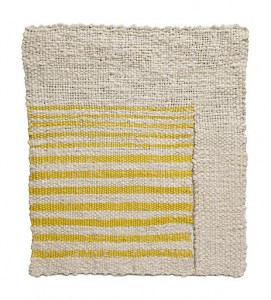
During the walk-through before the exhibition’s opening, Hicks declared that if she had made any work that needed an explanation, she apologized. She doesn’t need to. While visitors steeped in textiles may recognize specific techniques and understand just how unconventional her art has been within the field, anyone can appreciate the work which is made mostly of yarns by straightforward techniques of stacking, wrapping, draping, hanging, looping and weaving. The six-year old I took on my second visit responded enthusiastically; she was as captivated as I was by the floor pieces made of piled skeins of yarn, delighted by pieces made of crumpled paper and knotted rubber-bands, and curious about a vitrine filled with wrapped spheres, called Trésors et Secrets. Each contained a hidden object, destined to be forever secret. Hicks’ work reminds us of the endless, overlooked interest offered by the world around us, and as such, is a lesson in looking with a spiritual edge.
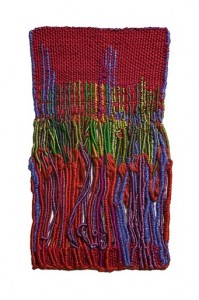
The exhibition was organized by Joan Simon and Susan C. Faxon for the Addison Gallery of American Art, Phillips Academy, Andover, MA and was brought to the ICA by Jenelle Porter (now curator at the Institute of Contemporary Art, Boston). It will travel to the Mint Museum in Charlotte, N.C. in October. The exhibition is accompanied by a luxurious and copiously-illustrated catalog (ISBN 978-0-300-12164-3), which includes an essay by Whitney Chadwick as well as one by each of the curators.
All images ©Sheila Hicks, All photographs ©Bastiaan van den Berg



